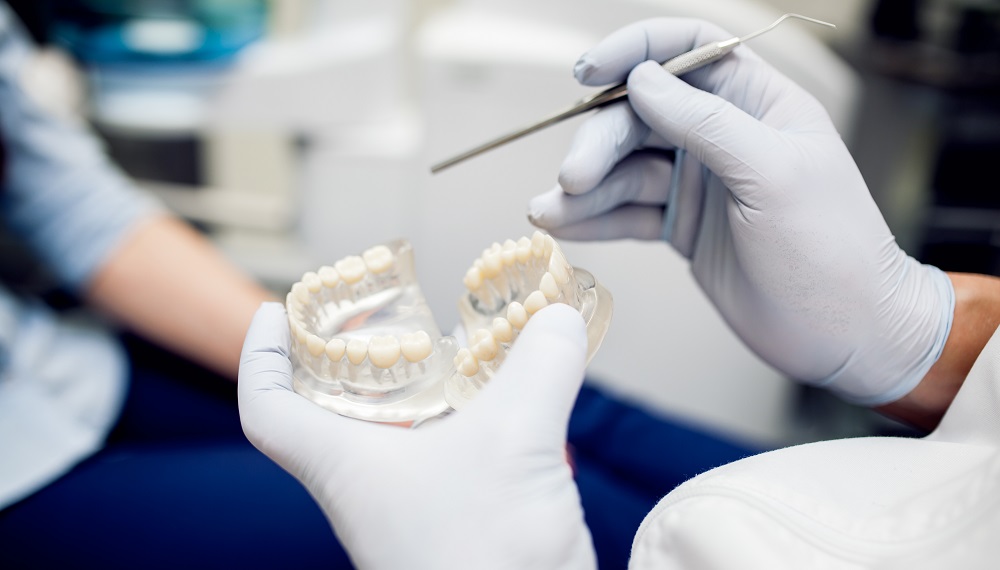Dental Prostheses

A dental prosthesis is an option used when there are missing teeth or tissue in the mouth. Depending on how many teeth are missing, both full and partial prostheses can be used. The new generation dental implants, which we use as dental prostheses, can also be used for this purpose. In modern prostheses, the aim is for the prosthesis to be fixed, provide comfortable chewing, and create an aesthetic tooth appearance.
What is Dental Prosthesis?
Artificial teeth prepared using different materials with the aim of replacing teeth lost for various reasons. It is applied to treat disruptions in aesthetics, speech (phonation), and chewing functions due to tooth loss.
What are the Types of Dental Prosthesis?
Dental prostheses are divided into fixed and removable prostheses.
What is a Fixed Prosthesis?
Crowns applied on a single tooth or bridges applied to complete multiple missing teeth are called fixed prostheses. They are divided into metal-supported and metal-free prostheses. As the name suggests, the prostheses are glued to the patient's mouth with special materials and cannot be removed by the patient. As long as cleaning rules are followed, they can remain in the mouth for many years.
How is a Fixed Prosthesis Applied?
First, anesthesia is applied to numb the teeth. Thus, the patient does not feel pain or discomfort during the procedure. Then, abrasions are made on the tooth surface using various equipment, and measurements are taken with special materials. The prostheses produced in the laboratory in a computer environment are attached to the tooth, and the treatment is completed.
How are Prostheses Selected?
The decision of whether to make metal-supported porcelain or metal-free porcelain prostheses is made by the dentist. Options are presented to the patient, taking into account factors such as comfort, aesthetics, function, long-term use, and cost. While metal-supported porcelain prostheses are functionally durable, they may not satisfy the patient aesthetically due to their lack of light permeability. For this reason, they are generally recommended to be applied in posterior areas. In regions where aesthetics is prominent, metal-free porcelain prostheses, which benefit from the property of light permeability, come to the fore. These are known as zirconium-based prostheses or full ceramic prostheses (e.g., emax).
What is a Removable Prosthesis?
Removable prostheses are prostheses that can be worn and removed by the patient. They are applied when multiple or all teeth are missing in a way that cannot be completed with a fixed prosthesis.
What are the Types of Removable Prosthesis?
In cases of multiple missing teeth, Partial Dentures are applied; in cases of total loss of teeth, Total Dentures are applied. Partial dentures are supported by nails or clasps taken from existing soft tissues and teeth. Total dentures, on the other hand, are prostheses in which all teeth are lost, supported by the existing jawbone and soft tissues; commonly known as 'dentures'.
What is a Precision Attachment Prosthesis?
Precision attachment prostheses are recommended for patients who are dissatisfied with the aesthetic appearance of metal-colored clasps and nails on partial prostheses. It is a type of prosthesis that provides patients with greater satisfaction in terms of retention and aesthetics, thanks to a mechanism in which attachment elements hidden in the prosthesis are used.
What is an Implant-Supported Prosthesis?
Prostheses placed on implants used to complete tooth loss. They can be applied as fixed and removable. Fixed implant-supported prostheses are applied in the form of crowns or bridges, similar to fixed prostheses. Removable implant-supported prostheses provide lip and cheek fullness by also performing the function of adding soft tissue in cases of insufficient bone level with a small number of implants, allowing restoration of the entire mouth.


